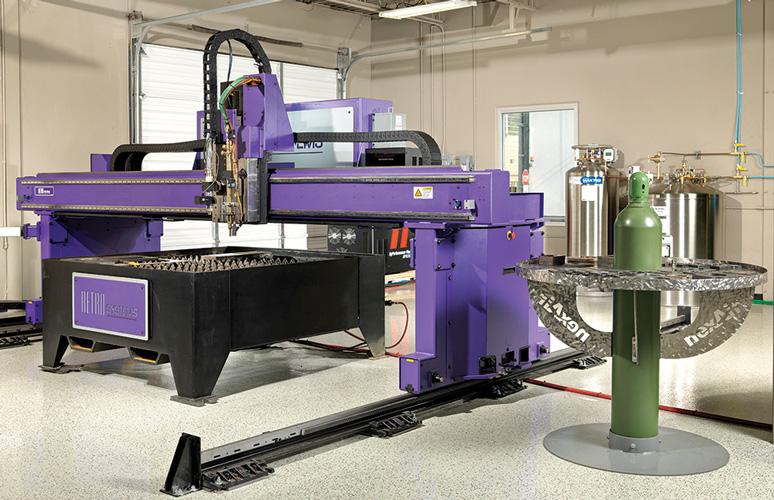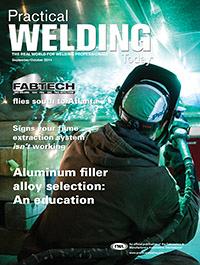Sales Engineer
- FMA
- The Fabricator
- FABTECH
- Canadian Metalworking
Categories
- Additive Manufacturing
- Aluminum Welding
- Arc Welding
- Assembly and Joining
- Automation and Robotics
- Bending and Forming
- Consumables
- Cutting and Weld Prep
- Electric Vehicles
- En Español
- Finishing
- Hydroforming
- Laser Cutting
- Laser Welding
- Machining
- Manufacturing Software
- Materials Handling
- Metals/Materials
- Oxyfuel Cutting
- Plasma Cutting
- Power Tools
- Punching and Other Holemaking
- Roll Forming
- Safety
- Sawing
- Shearing
- Shop Management
- Testing and Measuring
- Tube and Pipe Fabrication
- Tube and Pipe Production
- Waterjet Cutting
Industry Directory
Webcasts
Podcasts
FAB 40
Advertise
Subscribe
Account Login
Search
Weld shop 101
FAQs to help you build the right educational setting
- By Samantha Noland
- October 13, 2014
- Article
- Arc Welding

Cutting machines are a large investment so it’s critical to search for one that meets your needs. Analyze your environment and how you think you’ll use the machine, keeping in mind durability, capacity, and quality.
According to the American Welding Society (AWS), there will be a shortage of approximately 290,000 welders in the U.S. by 2020. To combat the shortage of skilled welders, it’s imperative that future generations be exposed to careers in welding and provided with opportunities to learn what those careers entail.
The responsibility to educate the next generation doesn’t fall on the shoulders of just high schools, community colleges, and technical programs; it also rests with industrial companies and businesses that have industry professionals on staff with experience and knowledge to share, and also have the facilities and equipment to provide hands-on learning opportunities.
The more hands-on learning and information sharing that can take place between industry professionals and the educational facilities in its community, the better positioned educators and instructors will be to provide the most accurate and up-to-date information to students.
It is for this reason that nexAir has opened the Advanced Welding and Cutting Demonstration Lab in Memphis, Tenn. The demonstration lab provides educators with an opportunity to receive a few days of hands-on training, the ability to ask questions, see state-of-the-art welding equipment up close, and learn about best practices in today’s welding environment. Arming educators with this information can only help make the next generation of welders that much stronger.
For those of you who are in areas where getting hands-on training for industry leaders isn’t possible, here are a few questions educators, especially those who are spearheading new welding programs, tend to ask. If you are looking to update your welding lab or are starting one up from scratch, these answers might help you get started.
Q: If I wanted to outfit my classroom with welding equipment, what are the essential items that I need to get started?
A: The basic requirements for a fully functioning weld shop are essentially the same as they would be for home hobby, production, and schools. The work area should include:
- A metal worktable with clamping abilities.
- Light curtains to protect the welder’s eyes, as well as the surrounding area.
- Basic tools, such as wrenches, pliers, grinders, and brushes.
- The welding machine and the wire or electrodes to go with it.
- Safety equipment including a jacket, helmet, gloves, and glasses.
Q: When might using metal-cored wire be beneficial?
A: Metal-cored wire is most beneficial in situations where you’re making flat welds that require high deposition. It can also be used to replace flux-cored wire when fumes or cleanup become an issue. Long, thick parts often show the greatest benefit from metal-cored wire.
Q: When is pulse welding applicable?

The equipment you need for a fully functioning weld shop in an educational setting is essentially the same as for home hobbyist, small fabrication, and production environments. Those essentials include safety curtains, personal protection equipment (PPE), basic hand tools, a welding power source and related consumables, and a sturdy worktable.
A: Pulse welding is most useful when a spray-transfer mode is too hot but the same deposition and quality are required. Pulse welding allows the spray transfer to be taken out of position, and it cycles between the spray settings and a cooler background voltage. This combination detaches a wire-sized droplet into the puddle without causing the spatter often seen in a globular transfer. Pulse welding is also good for nonferrous (shiny) metals, as it gives more of a rippling effect in the weld pool.
Q: What kind of power is required for this equipment?
A: Most of the equipment in our demonstration lab uses multivoltage so that it can be run on 230-V or 460-V power. Some pieces, however, like the high-definition plasma cutting table, require more power and have to be run at higher amperage. Overall, we keep the equipment flexible for demonstration and practical purposes.
Q: Will I need an engineer or a specialist to run or program a robot/cutting table?
A: No degree or specialization is required to run or program automated equipment. However, training is offered with the purchase of the equipment that will show you how to set the machine, program paths, and add parts.
Something that is more important than training is the programmer’s ability to understand the way the weld pool and arc function. Some of the best programmers are the skilled welders who know how to set torch angles and make appropriate wire and gas choices.
Q: What are important features to look for in a cutting machine?
A: Since cutting machines are a fairly large investment for anyone, it’s critical to search for one that meets your needs. Analyze your environment and how you think you’ll use the machine, keeping these categories in mind:
Durability. AC-drive motors are important to ensure a long-lasting machine; be sure to check these out before purchase.
Capacity. The cut thickness and plate capacity are important when deciding on the size of the cutting machine and table. Think about what you’ll be using it for and obtain these specifications from the vendors you’re choosing from.

Samantha Noland, sales engineer at nexAir, Memphis, Tenn., trains customers and area welding educators on welding best practices to make the fabricating process more efficient. Answering questions, as well as providing opportunities for hands-on learning, is the company’s way of filling the looming welder shortage. (Photos courtesy of nexAir, Memphis, Tenn.)
Quality. Take some time to look at a part that was cut by the machine you are considering. Make sure the quality required matches the quality offered either by having a part cut for you to compare or watching the machine work in person.
Q: How do I control fume generated by the cutting table?
A: We control the cutting table fumes by using a water table for steel and stainless steel and an exhaust/filtration system when we cut aluminum. We are also planning to install three wall-mounted filtration units to sit over our welding tables.
Q: Why can’t I cut aluminum over a water table to control the fume?
A: When you cut aluminum over a water table, chemical reactions occur between the aluminum and water that create hydrogen gas. The hydrogen can either become trapped in the water or even under the plate, which can lead to an explosion that damages the equipment and injures personnel.
About the Author
Samantha Noland
nexAir
363 Walnut St.,
Memphis, TN 38126
888-639-2474
About the Publication
subscribe now

The Welder, formerly known as Practical Welding Today, is a showcase of the real people who make the products we use and work with every day. This magazine has served the welding community in North America well for more than 20 years.
start your free subscription- Stay connected from anywhere

Easily access valuable industry resources now with full access to the digital edition of The Fabricator.

Easily access valuable industry resources now with full access to the digital edition of The Welder.

Easily access valuable industry resources now with full access to the digital edition of The Tube and Pipe Journal.
- Podcasting
- Podcast:
- The Fabricator Podcast
- Published:
- 04/16/2024
- Running Time:
- 63:29
In this episode of The Fabricator Podcast, Caleb Chamberlain, co-founder and CEO of OSH Cut, discusses his company’s...
- Trending Articles
Sheffield Forgemasters makes global leap in welding technology

Welding student from Utah to represent the U.S. at WorldSkills 2024

Lincoln Electric announces executive appointments

Lincoln Electric acquires RedViking

Engine-driven welding machines include integrated air compressors

- Industry Events
16th Annual Safety Conference
- April 30 - May 1, 2024
- Elgin,
Pipe and Tube Conference
- May 21 - 22, 2024
- Omaha, NE
World-Class Roll Forming Workshop
- June 5 - 6, 2024
- Louisville, KY
Advanced Laser Application Workshop
- June 25 - 27, 2024
- Novi, MI


























